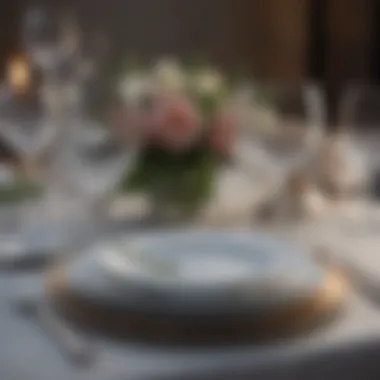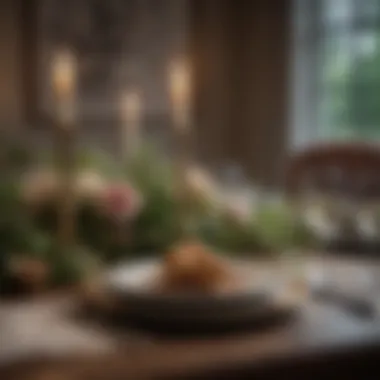Mastering the Formal Place Setting: A Comprehensive Guide


Intro
Setting a formal table is not just about plates and cutlery; it's an intricate dance of etiquette and design. When hosting sophisticated gatherings, the ability to create a polished dining experience can significantly enhance the overall ambiance. This process begins with understanding the components involved in a formal place setting. From the choice of tableware to the sequence of item placement, each decision plays a crucial role in presenting an environment that encourages both comfort and decorum.
Guests are likely to appreciate a thoughtfully arranged table, which goes beyond mere aesthetics. It signals respect for their presence and contributes to the enjoyment of the meal shared. Through this guide, you will learn not only the mechanics of setting a formal table but also the underlying principles of etiquette that elevate the experience.
Taking the time to master this art will empower you. Knowledge of formal dining can enhance your social interactions, making them more refined. We will explore the various elements that contribute to an effective setting. By the end, you will feel confident in your ability to host sophisticated gatherings.
Prologue to Formal Place Settings
Formal place settings are not just about aesthetics; they reflect a host's respect for their guests and the occasion. Setting a table formally elevates the dining experience, making it memorable and significant. The elaborate arrangement of tableware communicates attention to detail, refinement, and a genuine desire to create an enjoyable environment.
Understanding the structure and nuances of formal place settings is essential for anyone looking to enhance their entertaining skills. It allows hosts to establish a tone of sophistication and elegance. Additionally, adhering to formal settings can assist in navigating social interactions and elevate the status of any gathering from casual to elegant. This article serves as an in-depth guide to mastering this art, detailing essential items, etiquette, and practical tips for creating a polished dining experience.
Understanding the Importance of Formal Settings
Formal settings play a crucial role in the dining experience. They transform a simple meal into an event that resonates with significance and care. The components of a formal setting, such as plates, cutlery, and glassware, are not merely functional; they also serve as indicators of the occasion's formality.
A well-set table can impact the mood and atmosphere, subtly conveying messages of respect and appreciation toward guests. This setting also provides clear cues on how to behave and what is expected during the meal. A formal place setting streamlines dining, reducing confusion about which utensil to use and when. This clarity improves the flow of the meal and enhances overall enjoyment.
Contextualizing Formality in Dining
Formality in dining context emphasizes the distinct occasion being celebrated, whether it is a wedding, anniversary, or a gala dinner. Each situation dictates different expectations and styles of arrangement. Understanding these contexts helps in making informed decisions about how to set the table.
For instance, a formal dinner might require specific styles of tableware, such as bone china or silver cutlery, whereas a less formal gathering may allow a more relaxed and minimalist approach. Additionally, formal dining often incorporates established etiquette rules which smoothen interactions, ensuring guests feel prioritized.
The Essential Components of a Place Setting
A formal place setting requires careful selection and arrangement of various elements that together create a cohesive dining experience. Each component plays a vital role in presenting food and drink while adhering to established etiquette. Understanding these essential components helps in enhancing not only the aesthetic appeal of the table but also the overall experience of the meal.
Overview of Tableware
Tableware includes the items used for serving and consuming food. Proper knowledge of tableware elevates a dining experience. Each item contributes its own unique characteristic to the setting, establishing both functionality and style.
Plates
Plates are the foundation of any place setting. They come in various styles and sizes, ranging from dinner plates to salad plates. The key characteristic of plates is their ability to showcase the food beautifully. Porcelain plates, for example, are a popular choice due to their durability and elegant appearance. They provide a pristine backdrop for a range of dishes. However, one should consider weight; heavier plates can be cumbersome to manage. A well-selected plate creates a visually appealing presentation while being practical for the meal served.
Cutlery
Cutlery is essential for the dining experience, as it facilitates the consumption of food. Forks, knives, and spoons must be chosen with care. Stainless steel cutlery is a favored option due to its resilience and classic aesthetic. Its shine adds sophistication to the setting. A potential downside is that lower quality stainless steel can tarnish after multiple washes. Selecting the right cutlery not only enhances the visual appeal but also ensures comfort during the meal.
Glassware
Glassware is integral to a formal place setting. It encompasses water glasses and wine glasses, each designed with specific purposes. Crystal glass is a distinguished choice, appreciated for its clarity and brilliance. The refractive qualities of crystal can elevate the dining experience significantly. However, crystal glass is often more fragile than standard glassware, necessitating careful handling. A well-set table with appropriate glassware enhances the sophistication of the event.
Napkins
Napkins contribute not only to cleanliness but also to the overall aesthetic of a table. They can be folded in numerous styles, which adds a touch of creativity to the setting. Cloth napkins, in particular, are a preferred option for formal dining due to their texture and reusable nature. They lend a sense of elegance. On the downside, cloth napkins require laundering after use, and the care may deter some from using them.
Choosing the Right Materials


The choice of materials in tableware has a substantial impact on the dining experience. Each material presents distinct advantages as well as potential drawbacks that one must consider when planning a formal place setting.
Porcelain
Porcelain is widely recognized for its strength and beauty. It withstands temperature changes well, making it suitable for hot and cold dishes alike. Its smooth surface offers an exquisite canvas for food presentation. However, porcelain can be expensive, and care must be taken to avoid chipping. Considering these aspects is essential when opting for porcelain in a formal setting.
Stainless Steel
Stainless steel is another popular choice, especially for cutlery. Its longevity and resistance to rust make it extremely practical. Many people value its modern aesthetic, which complements a variety of table styles. The only noteworthy risk is that lower-quality stainless steel can show fingerprints and smudges, which may detract from the overall presentation. Evaluating quality when making selections ensures a polished dining experience.
Crystal Glass
Crystal glass is the epitome of luxury in glassware. Its delicate appearance and light-catching qualities elevate any dining occasion. Crystal glass can make even a simple meal feel extravagant. On the downside, its fragility requires meticulous handling and cleaning. Individuals must weigh the desire for opulence against the practicality of everyday use.
Understanding the essential components of a place setting can significantly enhance one's confidence in hosting formal events.
Arranging the Table Setting
Arranging a table setting is central to the overall dining experience. It is not just about placing dishes on a table; it reflects care, attention to detail, and respect for your guests. A well-arranged table enhances the aesthetic appeal and establishes an atmosphere that signals the formality of the occasion. Additionally, effective arrangement serves a practical purpose by facilitating a smooth dining process. By understanding the core principles and techniques involved, hosts can transform an ordinary meal into an extraordinary event.
Basic Principles of Arrangement
There are several fundamental principles to consider when arranging a table. Orderliness is paramount; items should be aligned and evenly spaced. Functionality is also key. Each component should be accessible while minimizing disruption during the meal. Furthermore, balance and symmetry contribute to a pleasing visual harmony that appeals to the eye. These elements together create a foundation that elevates the dining experience.
Placing the Dinner Plate
The dinner plate is often the focal point of a formal place setting. It typically sits at the center of the setting, with other items arranged around it. This positioning is crucial as it dictates the arrangement of all other tableware. Ensure there is adequate space—generally about one inch between the plate and adjacent items. This provides comfort during the dining experience. Moreover, consider the type of meal being served. Depending on the dish, using charger plates may further enhance presentation and add an additional layer of formality to your setting.
Arranging Cutlery: A Sequential Guide
Cutlery placement follows a specific order that emphasizes functionality and helps guests navigate the meal sequence seamlessly.
Forks
Forks should be placed on the left side of the dinner plate. The primary characteristic is their varied uses; different forks serve different courses. For instance, the salad fork is typically smaller, while the dinner fork is larger. This specification assists guests in easily identifying which utensil to use. The advantage of forks is their versatility, as they can be employed across multiple courses. However, improper placement can lead to confusion, stressing the importance of correct arrangement.
Knives
Knives are positioned to the right of the dinner plate, with the blade facing the plate. Their sleek design is not merely for aesthetic appeal but also offers a practical function in preparing and cutting food. Knives are a crucial component of the setting for meals that require cutting, like meat. It is wise to ensure that the sharp side always faces the plate, promoting safety and usability. While the presence of knives enhances the formal setting, improper handling may pose a risk of discomfort or injury to guests.
Spoons
Spoons are generally found to the right of the knives, used for soups or desserts. They are often the least used utensil in a formal setting but still vital for specific dishes. Spoons have a rounded design that encourages the consumption of food with a smooth texture. Their placement indicates the variety of courses offered, adding a layer of sophistication. However, including too many spoons may clutter the setting and confuse less experienced guests.
Positioning Glassware Effectively
Glassware arrangement plays a significant role in the table’s visual appeal. Proper spacing and placement of each glass are essential for optimal functionality and elegance.
Water Glass
The water glass typically resides above the knife on the right-hand side of the plate. It is essential for hydration throughout the meal. The transparency of crystal or glass enhances the aesthetic and allows for light to play through, creating an inviting table. Water glasses must be sizable enough to accommodate adequate servings while being easy for guests to access. Improperly placed glassware can lead to spills or clutter, which detracts from the dining experience.
Wine Glasses


Wine glasses are positioned to the right of the water glass. The placement should reflect the wine order—typically red to the left and white to the right. This arrangement not only promotes ease of access but also adds elegance through symmetry. The shape of wine glasses is designed to enhance the aromatic qualities of the respective wines. This nuance elevates the dining experience by encouraging appreciation of the wine's characteristics. However, too many wine glasses can overwhelm the table, causing confusion about which glass to use for which wine.
Placement of Napkins
Napkin placement completes the formal place setting. It serves both decorative and functional purposes.
Types of Folding
There are numerous styles for folding napkins, from simple rectangles to elaborate shapes. Each fold can signify a level of formality, making the choice more than just aesthetic. A folded napkin enhances the visual composition and hints at the meal's complexity, causing guests to feel special. While elaborate folds can impress, they may also come across as impractical if complex to unfold.
Positioning Techniques
Napkins can be positioned in various ways—on the plate, beside it, or in a glass. Each method offers a unique touch to the table arrangement. The choice of positioning often ties into the overall theme of the dining event. For example, placing a napkin in a glass creates an inviting environment implying hospitality. However, the practicality of the approach should also be considered, as awkward placement may lead to an unfriendly dining experience for guests.
By carefully considering these aspects when arranging a formal place setting, you can create a balanced, functional, and visually appealing dining experience that impresses your guests.
Adhering to Dining Etiquette
Adhering to dining etiquette plays a crucial role in elevating the experience of formal dining. It is not simply about following rules; it reflects respect for the occasion, the guests, and the art of dining itself. Understanding and practicing proper etiquette can transform a meal into a memorable event. It also helps in establishing a refined atmosphere that encourages meaningful conversations and connections among the diners.
Understanding Formal Dining Etiquette
Formal dining etiquette encompasses a set of guidelines that dictate behavior and practices at the table. It involves various elements, including posture, utensil usage, and conversational norms. Familiarity with these standards fosters confidence in both hosts and guests.
Some essential aspects of formal dining etiquette include:
- Posture: Maintain an upright posture throughout the meal. It conveys attentiveness and respect.
- Utensil Usage: Use utensils from the outside in, beginning with those farthest from the plate for each course.
- Manners: Avoid discussing sensitive topics and respect silence during the meal, unless engaging in pleasant conversation.
By adhering to these core principles, participants can ensure a smooth dining experience that respects traditions and enhances enjoyment.
The Roles of Host and Guests
In a formal dining situation, the roles of host and guests are clearly defined, contributing to the overall atmosphere. The host has a responsibility to facilitate a welcoming environment while the guests must show appreciation and respect.
Responsibilities of the Host:
- Planning: Carefully plan the menu and setting, ensuring all elements are aligned with the theme of the gathering.
- Welcoming Guests: Greet guests warmly and introduce them to one another, setting a friendly tone for the evening.
- Managing the Flow: Oversee the progression of the meal, ensuring that courses are served in a timely manner.
Responsibilities of the Guests:
- Arriving on Time: Being punctual shows respect for the host and the planned schedule.
- Engagement: Participate in conversations, but avoid dominating discussions or making others uncomfortable.
- Expressing Gratitude: Show appreciation for the host’s efforts, either during the meal or in a follow-up thank-you message.
Through understanding these roles, both hosts and guests can elevate the dining experience, making it enjoyable and memorable for everyone involved.
Enhancing the Dining Experience
Enhancing the dining experience encompasses various elements that collectively create an enjoyable and memorable occasion. The ambiance, table linens, and even the music played in the background can significantly affect how guests perceive the meal and the event itself. It’s not just about serving good food; it’s about fostering an atmosphere that encourages engagement and enjoyment. This thoughtful attention to detail can elevate a standard gathering into a sophisticated celebration.
Ambiance and Setting
Lighting
Lighting plays a pivotal role in establishing the overall mood of a formal dinner. It governs how guests see the table setting, the food, and each other. Soft, warm lighting is often preferred as it creates an inviting atmosphere and makes everyone look more appealing. Dimmed lights paired with candles can generate a sense of intimacy.
A key characteristic of effective lighting is that it can easily be adjusted to match the progression of the evening—from appetizers to dessert. This adaptability is important. However, one must be cautious; overly bright or harsh lighting can be jarring and detract from the experience, turning a lavish gathering into a mundane meal.


Table Linens
Table linens are another critical aspect of setting a formal dining experience. Selecting high-quality tablecloths and napkins not only adds elegance but also protects your table from spills and stains. A good fabric choice like linen or high-thread-count cotton exudes sophistication and enhances tactile experience for guests.
A notable advantage of using table linens is their decorative potential. They can be chosen to match the theme or color scheme of the event, creating a cohesive look. However, it's essential to avoid patterns that are too busy, as they can distract from the place settings and the food itself.
Centerpieces
Centerpieces can serve as the focal point of the table, adding depth to the overall setting. A well-chosen centerpiece can complement the tableware and enhance the atmosphere. Options range from floral arrangements to elegant candlesticks, depending on the formal tone one wishes to achieve.
The key characteristic here is balance. Centerpieces should be tall enough to impress but not so towering that they obstruct conversation. They should enrich the experience rather than dominate it. Moreover, seasonal elements can be an excellent way to reflect the time of year, adding a touch of freshness.
Selecting Appropriate Music
Music can subtly influence the mood during a meal. Selecting appropriate background music sets the tone for the evening. Classical pieces or gentle jazz often fit well in formal dining situations, creating an unobtrusive yet engaging soundscape. It's not merely about choosing something pleasant to the ear; the right music can prompt conversations and enhance the dining experience without overwhelming any discussion.
In summary, enhancing the dining experience is an intricately woven process that involves careful consideration of various factors. Each element, from lighting to music, contributes to an environment that can profoundly impact how a meal is perceived and enjoyed.
Practical Tips for Executing a Formal Place Setting
Executing a formal place setting requires attention to detail and a nuanced understanding of the different components involved. The significance of this section cannot be understated, as small errors can lead to a less polished dining experience. Knowing the practical tips ensures the gathering goes smoothly, impressing guests with your hosting skills.
A formal place setting is not just about aesthetics; it is a visual language that conveys respect and consideration for your guests. Here, we will provide insights into common missteps to avoid and suggest resources for further knowledge.
Common Mistakes to Avoid
When setting a formal table, certain pitfalls can detract from the overall impression. To help you avoid these, consider the following mistakes:
- Overcrowding the Table: Clutter can overwhelm guests, making it difficult to enjoy the meal. Each setting should provide enough physical space to create a comfortable dining experience.
- Incorrect Item Placement: Misplacing cutlery or glassware can lead to confusion. Always remember, forks go on the left, knives and spoons on the right.
- Using Inappropriate Tableware: It is crucial to use items suitable for the occasion. Avoid casual dinnerware for formal settings. Instead, utilize fine china, high-quality cutlery, and crystal glass.
- Neglecting Napkin Presentation: A poorly folded napkin can appear unrefined. Take time to either fold napkins elegantly or use napkin holders to enhance their presentation.
"A well-set table serves as both a functional and artistic expression of the host's intentions."
Being conscious of these factors can enhance the overall impact of your dinner setting.
Resources for Further Learning
To excel in mastering formal place settings, consider exploring additional materials that provide depth and insights into dining etiquette and table arrangements. Here are some reliable resources:
- Books: Check out titles like "Emily Post's Etiquette" or "The Art of Dining: A History of the TABLE" for comprehensive guides on etiquette and dining setups.
- Websites: Utilize reputable sites such as Britannica and Wikipedia for quick reference on formal dining customs.
- Forums: Engage in discussions on platforms like Reddit where enthusiasts share experiences and advice.
- Online Courses: Consider enrolling in an etiquette class that offers training on formal dining, which usually covers everything from place settings to social interactions at the table.
In sum, understanding mistakes to avoid and seeking further resources can significantly enhance your ability to execute a formal place setting effectively. These tips provide a solid foundation for executing an elegant and memorable dining experience.
Epilogue
The conclusion of this article serves as an important culmination of the myriad elements discussed regarding formal place settings. It encapsulates the intricate details and significance of executing a well-prepared formal dining experience. Having an understanding of each aspect of a place setting enhances not only personal hosting skills but also creates a refined atmosphere that can elevate social interactions.
Formal dining goes beyond mere aesthetics; it is an expression of respect for guests and the culinary experience. By mastering the formal place setting, hosts can ensure that their gatherings reflect thoughtfulness, attention to detail, and elegance. The knowledge acquired from this guide empowers individuals to navigate various social occasions with confidence.
Recap of Key Points
In summary, the article explored key components and practices necessary for setting a formal table:
- Understanding Tableware: Each item, from plates to glassware, has a designated purpose.
- Arrangement Techniques: Proper placement follows a sequence, helping guests feel comfortable and at ease.
- Dining Etiquette: Knowledge of formal dining practices enhances the experience for everyone involved.
- Enhancing Ambiance: A well-curated environment contributes greatly to the overall dining atmosphere.
This recap emphasizes the integration of these elements to achieve a successful formal setting.
The Lasting Impression of Formal Dining
A well-executed formal dining event leaves memorable impressions on guests. The effort put into the presentation reflects good taste and consideration for their experience.
A formal place setting is not merely about appearance; it embodies the essence of hospitality.
Such gatherings can foster deeper connections among guests and create lasting memories. They can also enhance one's reputation as a skilled host, opening doors to future social opportunities. A polished dining experience can undoubtedly transform an ordinary meal into an extraordinary occasion.







